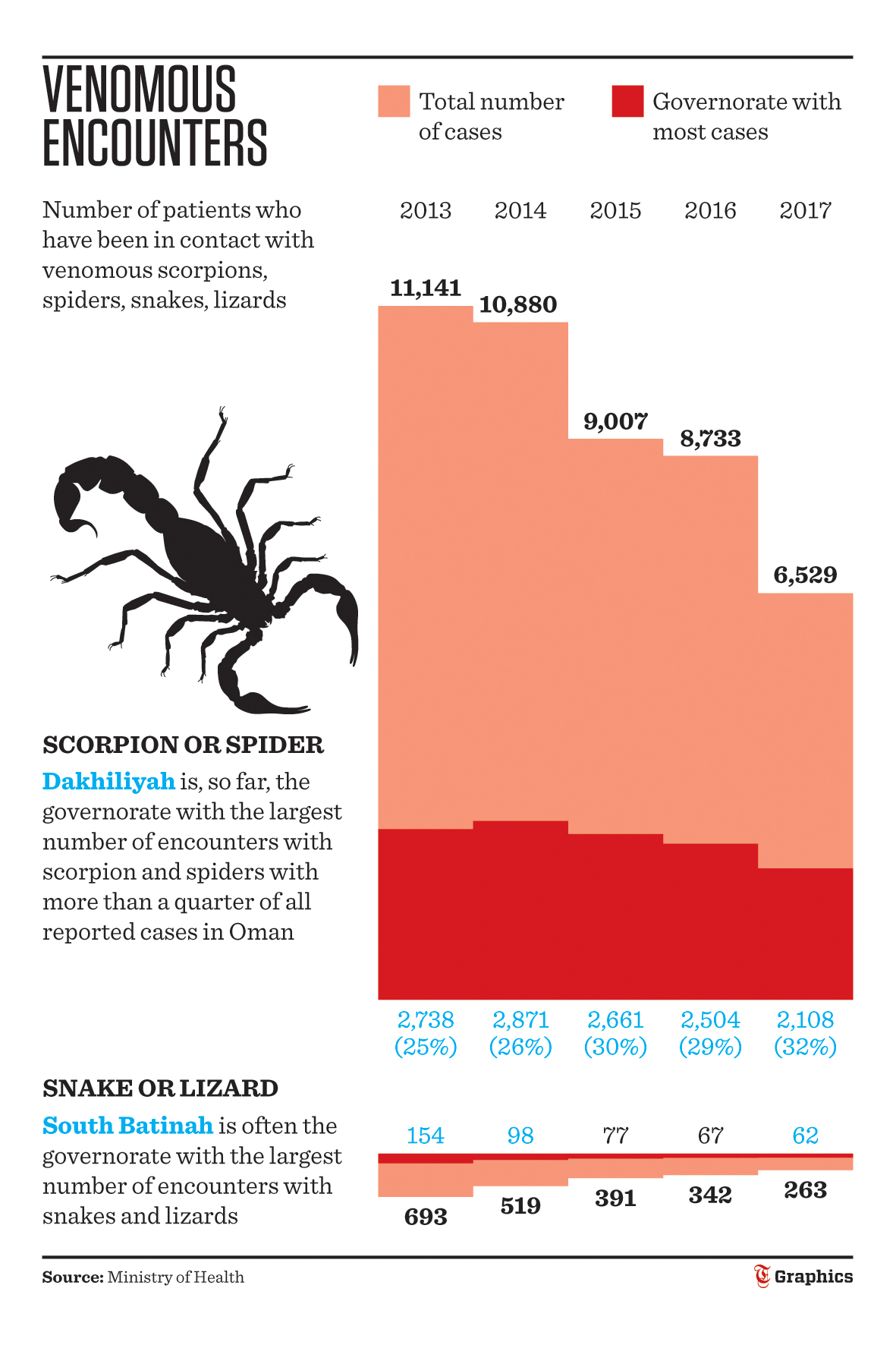
Muscat: Over 6,500 people came in contact with venomous snakes, spiders and scorpions in Oman last year, according to statistics released by the Ministry of Health.
The year 2017 saw a 25 per cent decrease in the number of people who were bitten by venomous spiders and scorpions. Some 8,733 patients visited government hospitals in 2016 to be treated for venomous bites, while last year, the number fell to 6,529.
**media[922821]**
Similarly, the number of people who came in contact with a venomous snake or lizard also decreased from 342 in 2016 to 263 in 2017.
“When patients arrive at the emergency department after a venomous bite, they get assessed for signs and symptoms of local and systematic toxicity,” said Dr Suad Abdullah Al Abri, emergency medicine consultant and medical toxicologist, SQUH emergency department.
“Toxicity will differ according to the type of bite or sting. For example, usually, scorpion stings cause significant local pain and some swelling with less systematic toxicity, except in some cases, specially among children,” Al Abri added. “Whereas snake bites commonly cause local and systematic toxicity, mainly local tissue destruction, deranged blood clotting, and some times, renal and neurological involvement.”
According to the annual report of the Ministry of Health, there were 131 in-patients who went to government hospitals due to bites from a venomous spider or scorpion last year, the majority of whom were children between the ages of 1 and 4.
“The treatment depends on the patients, and usually, we follow the national poisoning guidelines,” Al Abri said, adding, “There is an anti-venom available for scorpion and snake envenomation and it is used depending on the toxicity, as mild cases may not need it.”
“Patients get observed in the emergency department for progression of toxicity even if they present mild symptoms, and if they need an anti-venom, they get admitted for further monitoring,” added Al Abri.
Al Dhakiliyah topped the list of governorates in reporting cases of spider bites, with 2,108 patients, followed by Dhahirah with 1,144 patients. On the other hand, Al Buraimi, Muscat, and Musandam had the least number of cases involving bites from venomous spiders or scorpions.
Haliyas Al Hashmi, head of the awareness department at Jalan Bani Bu Ali Municipality, said, “Since we live in a desert area, it is full of such creatures.”
“During the summer, these creatures come out more during the evenings when the temperature declines. Most people love going camping, so it is important to choose locations carefully; people should camp in the high hills at night and avoid the low areas,” said Al Hashmi.
Traditional methods
“In general, there have been no cases of serious stings or death, and people in the area are used to scorpions and are good at dealing with them. Many people in the area follow traditional methods of removing the poison from a bite until they reach the hospital,” Al Hashmi added.
In order to avoid such cases, local tour guides have come up with methods to prevent tourists from coming in contact with such creatures.
Mohammed Al Ruqaishi, a tour guide from Al Jabal Al Akhdar, said, “When we camp, we sleep in open areas, away from trees to avoid such creatures.”
Al Ruqaishi added: “We have never had a case of a venomous bite during our group tours, but if it occurred, we have a method that we use: we wash the injured and keep him/her still and remove any tight objects such as rings, watches or tight clothing and get them to the nearest hospital immediately.”
Several species
Oman has several species of snakes that live in sandy places, mountains or the sea, such as mole vipers, horned vipers, the Arabian cobra and the black desert cobra.
The red back and the violin spider are the most common spiders found in Oman.
Scorpions live in the desert and the rocky countryside and are usually only seen when people move rocks or logs, which they hide under.